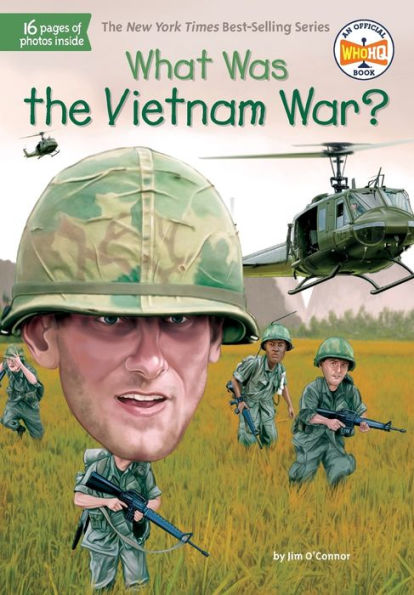Read an Excerpt
What Was the Vietnam War?
In 1969, the fight over “Hamburger Hill” was typical of the no-win battles fought again and again during the long Vietnam War. (You say Vietnam like this: vee-et-nahm.)
For ten days, a very bloody battle raged on the hill. It was in central Vietnam, near its western border. On US maps, it was simply labeled as Hill 937. US Marine and Army units were fighting together with soldiers from South Vietnam. They wanted to capture the hill, which was under enemy control. It was on the enemy’s main route for supplies.
Who was the enemy?
The communist forces known as the North Vietnamese Army (NVA).
When the NVA finally abandoned Hamburger Hill, they left behind the bodies of almost seven hundred of their soldiers. As for the US and South Vietnamese army forces, they lost a total of 72 men, and another 372 were wounded.
Hamburger Hill was considered a victory for the United States and South Vietnam. But after occupying the hill for only a few days, they abandoned it to move on to a new battleground. Very quickly, the NVA took back the hill.
So what was gained in the battle?
Fifty years later, many questions about the Vietnam War are still being debated. What were the reasons for US troops fighting in Vietnam, a small Southeast Asian country on the other side of the world? Why did North Vietnam end up winning? What made the United States government wait so long to pull its troops out? And, most important of all, were any lessons learned?
Chapter 1: Where Is Vietnam?
The Socialist Republic of Vietnam (that is the country’s name today) is a small country in Southeast Asia. It is smaller than the state of California. Vietnam is bordered by China to the north; Laos, as well as Cambodia, to the west; and the South China Sea to the east. It has a tropical climate, with temperatures often nearing one hundred degrees Fahrenheit. The coasts, where the land is flat and open, are great for growing rice, so Vietnamese people eat a lot of it. It’s mountainous in the central and northern parts of the country, and there are dense jungles throughout the far south.
Today, Vietnam has a population of around ninety-six million. But at the end of the Vietnam War, there were only about forty-four million people. Now, 61 percent of the population is under the age of thirty-five. Hanoi (say: hah-noy) is the capital and the second-largest city after Ho Chi Minh City (say: hoh chee min). (Until the war’s end, it was known as Saigon.)
For two thousand years, Vietnam’s greatest enemy was China. China invaded Vietnam many times and finally conquered it in 111 BC. The Chinese ruled the country for over a thousand years.
The Vietnamese hated the Chinese and tried many times to regain their independence. Finally, in AD 939, they were successful. The Chinese rulers were pushed out. After that, the Vietnamese ruled themselves until the middle of the nineteenth century.
That is when the French arrived. It was an era when many countries in western Europe decided to colonize (seize control of) countries in southern Asia and in Africa. By 1884, France had control of all of Vietnam.
Over the next seventy years, the French held Vietnam. They tried to make as much money off the country as they could. The French exported so much of the rice grown in the south that there was not enough for the Vietnamese peasants to eat.
The French in Vietnam grew rich. Many lived on large plantations where they grew rubber trees, tea, coffee, and, most of all, rice. They paid no taxes on their income. The poorest Vietnamese people were heavily taxed on the little money they made.
The French used Vietnamese workers to build roads, bridges, and railroads. They built many beautiful buildings in Saigon. One railroad line went from Saigon in the south to Hanoi in the north, a distance of about one thousand miles. However, instead of paying for labor, the French forced entire villages to work on the railroad line for free. Many workers, underfed and overworked in the tropical heat, became ill and died. Twenty-five thousand Vietnamese people, as well as Chinese workers, died building one three-hundred-mile stretch of railway.
To make a lot of money, the French also encouraged the Vietnamese to use the drug opium. Opium comes from the poppy flower, and poppies grow easily in Vietnam. The French set up a building for processing opium in Saigon. It produced opium that was very pure and burned fast. (Opium is smoked through a pipe.) Opium addiction grew. The Vietnamese bought more and more opium. The French taxed opium sales so heavily, at one point the drug counted for one-third of Vietnam’s economy.
Anyone who objected to the way France was ruling Vietnam ended up in jail. Some protesters were even executed.
The treatment of the Vietnamese people was terrible. Many of them wanted the French to go. Of course, the French government was not going to leave willingly. They would have to be forced out.
To the Vietnamese, this was the beginning of a revolution for independence. To the French, and later the Americans, it was the beginning of a war.
By the late 1930s, Vietnamese rebels began grouping together to fight a war of resistance against French rule. In World War II, when Japan invaded Vietnam, the rebels fought against the Japanese, too. The rebels called themselves the Vietminh (say: vee-et-min). That meant “League for the Independence of Vietnam.”
After World War II ended with Japan’s defeat, the French wanted to control Vietnam again. France had always been on great terms with the United States—ever since the American Revolution, in fact. So the United States was on the side of the French.
For the Vietminh, the United States was now seen as an enemy, too.




